Amano R.S., Sunden B. (Eds.) Computational Fluid Dynamics and Heat Transfer: Emerging Topics
Подождите немного. Документ загружается.


Sunden CH009.tex 25/8/2010 10: 57 Page 356
356 Computational Fluid Dynamics and Heat Transfer
In theAWF, the wall shear stress isobtainedby theanalytical solution ofa sim-
plified near-wall version of thetransport equationfor the wall-parallelmomentum.
Theresultantshearstressformhereisthesameasthatfortheroughwallturbulence
but with the slip velocity U
w
in the integration constant A
U
.
Since thewall permeability alsomakes the flowmore turbulent, y
∗
v
should have
its dependency. Equation (38) is thus further modified as
y
∗
v
= y
∗
vs
1 −(h
∗
/70)
m
− f
K
(70)
where f
K
is a function of the permeability. By referring to the experiments and
the DNS data [32, 33], the range of y
∗
v
which depends on the wall permeability
is estimated. Considering the roughness effects in y
∗
v
, the optimised function in
equation (70) for the permeability effects is
f
K
= 3.7
1 −exp
=
−
K
∗
6
2
>
(71)
whereK
∗
=
√
Kk
P
/ν. In thisform, K
∗
is usedrather thanRe
K
since theAWF uses
√
k
P
for the velocity scale. In order to keep consistency with such normalisation,
Equation (68) is rewritten as
f
α
p
exp
−
K
∗1.68
250
(72)
using the relation of Re
K
c
1/4
µ
K
∗
. The following modified form, however, is
employed after further tuning of the model function
f
α
p
= exp
−
K
∗1.76
180
(73)
Examples of applications
Permeable-wallchannelflows. Inordertoconfirmtheperformanceofthemethod,
computationsoffullydevelopedturbulentflowsinaplanechannelwithapermeable
bottomwallaty/H =0andasolidtopwallaty/H =1(seeFigure9.18a)areshown
here. The considered flow conditions are the same as those in the DNS [33]. The
mean diameter of the particle composing the permeable beds is d
p
/H =0.01 and
their porosity areϕ =0.95,0.80,0.60,0.00.The permeability and the Forchheimer
termarethenobtainedbyequations(52)and(53).ThebulkflowReynoldsnumberis
Re
b
=5,500inallthecases.Theroughnessheightisconsideredtobeh=d
p
inthis
practice.Thegridcellnumberusedisonly10inthewallnormaldirectionduetothe
use of the wall-function approach for such relatively low Reynolds number flows.
The turbulencemodels usedare the standardk-ε model[4] and thetwo-component
limit (TCL) second moment closure of Craft and Launder [39].
Figure 9.19a compares the mean velocity distribution inside the porous walls.
The obtained velocity profiles are from equation (60). Whilst there can be seen
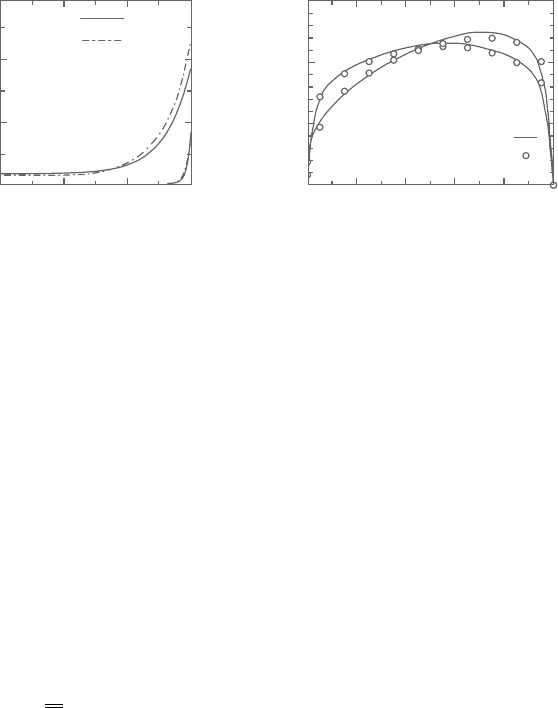
Sunden CH009.tex 25/8/2010 10: 57 Page 357
AWFs of turbulence for complex surface flow phenomena 357
0.3
1.5
1.0
0.5
0.95
w = 0.80
w = 0.95
0.0
0.80
Re = 5500
0.0 0.2 0.4 0.6 0.8 1.0
Present
Present
DNS
DNS
0.2
0.1
0.0
y/H
y/H
(b)(a)
−0.15 −0.10 −0.05 0.00
U/U
b
U/U
b
Figure 9.19. Meanvelocitydistribution:(a)insideporouswalls,(b)channelregion.
a margin to be improved in the comparison between the present and the DNS
results in the case of ϕ =0.95, the agreement is virtually perfect in the case of
ϕ =0.80.
The mean velocity distribution in the channel region is compared in Figure
9.19b. Itis obvious thatthe computationwell reproducesthe characteristicvelocity
profiles near the permeable walls.
The AWF is also applicable to the second moment closures. Figure 9.20a–c
compares the obtained Reynolds stress distribution by the second moment closure
[39]. Due to the use of theAWF, it seems hard to capture the near wall peaks of the
Reynolds normal stresses as inFigure 9.20a and b. However, general tendencies of
the distribution profiles are satisfactorily reproduced by the present scheme.
Turbulent permeable boundary layer flows. The other test cases are turbulent
boundary layerflowsover permeablewalls.Thesame flow conditionsof the exper-
iments of Zippe and Graf [32] are imposed in the computations. The free stream
turbulenceis
#
u
2
/U
0
= 0.35×10
−2
.TheReynoldsnumber basedon themomen-
tum thickness ranges Re
θ
= 1.3−2.1 ×10
4
.Although it was not reported in Ref.
[32], the permeability can be estimated by equation (52) as K = 2.54 × 10
−9
m
2
since the experimentally used mean diameter of the ellipsoidal beads composing
thepermeablebed was d
p
= 2.883mm.The presently appliedporosity isϕ 0.30
considering the effects of non-spherical shapes of beads used in the experiments.
(The porosity of a fully packed body-centred cubic structure by spherical beads
is ϕ = 0.26. Zippe and Graf did not report about the porosity as well.) The grid
cell number used is 120 × 150 for the developing boundary layer computations.
The turbulence model used is the standard k-ε model of Launder and Spalding [4].
Since Zippe and Graf [32] also did not report the roughness height of their test
cases, it is presently estimated as h
+
116 comparing the experimental velocity
profile with the formula of Nikuradse [20]: Equation (36).
Figure 9.21 compares the mean velocity profiles where their boundary layer
thicknesses correspond to each other. The cases are R (non-permeable rough

Sunden CH009.tex 25/8/2010 10: 57 Page 358
358 Computational Fluid Dynamics and Heat Transfer
3
w = 0.95
w = 0.95
w = 0.80
0.80
0.0
DNS :
DNS
present :
present
2
1
0
−1
0.0
(a) (b)
(c)
0.2 0.4 0.6 0.8 1.0
4
3
2
1
0
0
0.0
0.2 0.4 0.6 0.8 1.0
y/H
y/H
4
3
2
1
0.0
0.2 0.4 0.6 0.8 1.0
y/H
uv
U
2
τ
u
2
/U
τ
√
v
2
/U
τ
√
w
2
/U
τ
√
DNS
present
u
2
/U
τ
√
v
2
/U
τ
√
w
2
/U
τ
√
Figure 9.20. Reynolds stress distribution in permeable channel flows.
Expt. present
20
10
0
100 1,000
y
+
U
+
10,000
R
P
12.5
P16.5
Figure 9.21. Mean velocity distribution in permeable boundary layers.
wall boundary layer), P
12.5
(permeable wall boundary layer with U
0
=12.5m/s)
and P
16.5
(permeable wall boundary layer with U
0
=16.5m/s). Obviously, the
presentschemereasonablyreproducestheexperimentallyobtainedvelocityprofiles
with/without the permeability.

Sunden CH009.tex 25/8/2010 10: 57 Page 359
AWFs of turbulence for complex surface flow phenomena 359
0
5
10
15
20
25
1 10 100 1,000 10,000
y
+
Re = 10
5
Pr = 0.71
0.2
0.1
0.025
LS(Pr = 0.71)
k-ε + AWF
Kader
Θ
+
Figure 9.22. MeantemperatureprofilesinturbulentsmoothchannelflowsatPr< 1.
9.4.5 AWF for high Prandtl number flows
If oneconsiders to predict turbulentwall heattransfer of high Prandtlnumber fluid
flows such ascooling oil andICengine water-jacketflows, itis essential toanalyse
the thermal boundary layer which is much thinner than that of the flow boundar y
layer. Thus, near-wall modelling which resolves the viscous sub-layer has been
thought to be essential for high Pr thermal fields. For example, at the development
ofanovelturbulentheatfluxmodelapplicabletogeneralPrcases,Rogersetal.[40]
supposed correct near-wall stress distribution and Suga andAbe [41] employed an
LRN nonlinear k-ε model. So and Sommer [42] also applied an LRN k-ε as well
as a near-wall stress transport model for flows at Pr=1000.
However, even with the recent development of LRN heat transfer models,
wall-function approaches still attract industrial engineers. Its reasons are a high
computational cost of the LRN computation and difficulty of generating quality
near-wall grids for complex 3D flow fields such as an IC engine water jacket.
AlthoughtheAWFperformsreasonablywellatPr< 1asshowninFigure9.22,
4
itsapplicabilitytohigherPrcaseshasnotbeendiscussedwellsofar.Therefore,this
part focuses on the improvement of the thermal AWF for high Pr turbulent flows
with and without wall roughness [12].
High PrAWF for smooth wall heat transfer
IntheAWF forsmoothwallheattransfer,µ
t
variationisassumedthat µ
t
iszero for
y
∗
≤y
∗
v
=10.7and then increaseslinearlyas of equation(16). Since thetheoretical
4
Inthecases shown in Figure 9.22, theconstantPr
t
=0.9 is used forconvenience.However,
for lower Pr cases, it is well known that higher values of Pr
t
should be used [43]. There is
thus a tendency for the AWF to underpredict the mean temperature profile, particularly, at
Pr=0.025.
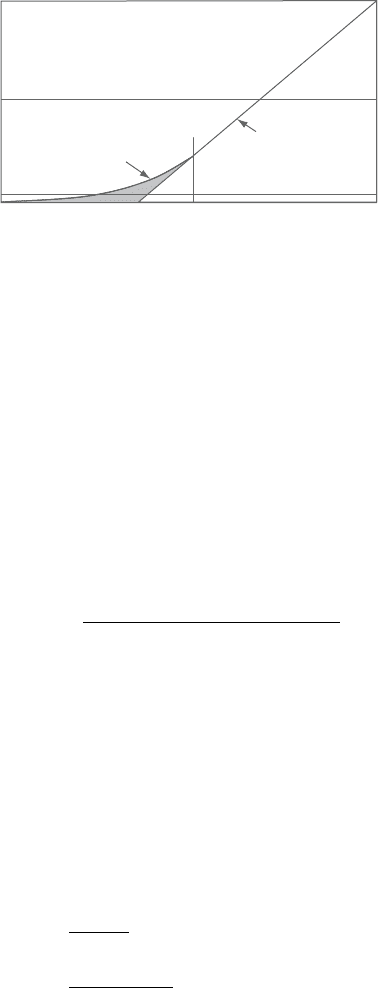
Sunden CH009.tex 25/8/2010 10: 57 Page 360
360 Computational Fluid Dynamics and Heat Transfer
a′my
∗
3
/Pr
t
m/Pr :(air)
m/Pr : (oil)
m
t
/Pr
t
y
∗
ν
y
∗
b
Thermal diffusivities
am(y
∗
−y
∗
ν
)/Pr
t
Figure 9.23. Near-wall thermal diffusivity distribution.
wall-limitingvariationof µ
t
is proportional toy
3
, this assumptiondoes not counta
certainamountofturbulentviscosityintheviscoussub-layer.Despitethat,itseffect
is not serious for flow field prediction since the contribution from the molecular
viscosity is more significant in the sub-layer.This is also true for the ther mal field
predictionoffluidswhosePrislessthan1.0. However, inhighPrfluidflowssuchas
oil flows, since the effect of the molecular thermal diffusivity (µ/Pr)becomesvery
small as illustrated in Figure 9.23, it is then necessary to consider the contribution
from the turbulent thermal diffusivity inside the sub-layer. (Note that a prescribed
constant turbulent Prandtl number Pr
t
is assumed in Figure 9.23.)
In order to compensate the thermal diffusivity inside the sub-layer, Gerasimov
[17] introduced an ad hoc effective molecular Prandtl number as:
Pr
eff
=
Pr
1 +0.017Pr(1 + 2.9|F
ε
− 1|)
1.5
(74)
where F
ε
is a model function. This effective Pr approach was tailored for water
flows.Thus, its performance in oil flows whose Pr is over 100 is not guaranteed.
In order to improve the µ
t
profile inside the sub-layer, it is assumed that the
profileofEquation(16)isconnectedtoafunctionα
y
∗3
atthepointy
∗
b
,asillustrated
in Figure 9.23.
µ
t
/µ =
$
α
y
∗3
, for 0 ≤ y
∗
≤ y
∗
b
α(y
∗
− y
∗
v
), for y
∗
b
≤ y
∗
(75)
Thus,
θ
=
⎧
⎪
⎪
⎨
⎪
⎪
⎩
1 +
α
Pry
∗3
Pr
t
=
θa
, for 0 ≤ y
∗
≤ y
∗
b
1 +
αPr(y
∗
− y
∗
v
)
Pr
t
=
θb
, for y
∗
b
≤ y
∗
(76)
where µ
θ
/Pr is the total thermal diffusivity. By referring to the near-wall profile
of µ
t
in a DNS dataset, the value of y
∗
b
is optimised as y
∗
b
= 11.7 and thus α
is

Sunden CH009.tex 25/8/2010 10: 57 Page 361
AWFs of turbulence for complex surface flow phenomena 361
obtainable as:
α
=
α(y
∗
b
− y
∗
v
)
y
∗3
b
=
α
y
∗3
b
(77)
Using equation (76), integration in equation (18) can be made. Although the
modification of the modelis very simple, it makes the analytical integration a little
cumbersome as below.
When y
b
≤ y
n
, with P
2
=1/
θa
, P
2
= 1/
θb
, y
0
= 0,y
1
= y
b
and y
2
= y
n
,
the coefficients D
T
and E
T
of equation (45) and (46) are:
D
T
= S
2
(y
1
) −S
2
(y
0
) +{S
2
(y
2
) −S
2
(y
1
)}
P
2
(y
1
)
P
2
(y
1
)
(78)
E
T
= S
1
(y
0
) −S
1
(y
1
) +S
1
(y
1
) −S
1
(y
2
)
(79)
+{S
2
(y
1
) −S
2
(y
2
)}
P
1
(y
1
) −P
1
(y
1
)
P
2
(y
1
)
where P
1
= y
∗
P
2
, P
1
= y
∗
P
2
, S
i
=
/
P
i
dy
∗
.
In the case of y
n
< y
b
, with y
0
= 0,y
1
= y
n
, they are:
D
T
= S
2
(y
1
) −S
2
(y
0
) (80)
E
T
= S
1
(y
0
) −S
1
(y
1
) (81)
(SeeAppendix B for the results of the integration of 1/
θa
etc.)
High PrAWF for rough wall heat transfer
Since theAWF heat transfermodel presented sofar was only validated in airflows,
the coefficient C
h
needs recalibration inhigh Pr flows and theobtained polynomial
form is:
C
h
= max(0,C
3
Pr
3
+ C
2
Pr
2
+ C
1
Pr +C
0
) (82)
C
3
=−0.48/h
∗
+ 0.0013, C
2
= 9.90/h
∗
− 0.0291
C
1
=−72.35/h
∗
+ 0.3067, C
0
= 98.98/h
∗
+ 0.2103
Since the rough wallAWF modifies y
∗
v
of Equation (38) as:
y
∗
v
= y
∗
vs
$
1 −
h
∗
70
m
%
= y
∗
vs
− δ
v
(83)
the turbulent viscosity form of equation (75) changes to:
µ
t
/µ =
$
α
(y
∗
+ δ
v
)
3
, for y
∗
≤ y
∗
b
α(y
∗
− y
∗
v
), for y
∗
b
< y
∗
(84)

Sunden CH009.tex 25/8/2010 10: 57 Page 362
362 Computational Fluid Dynamics and Heat Transfer
Then, the thermal diffusivity has the following forms:
θ
=
⎧
⎪
⎪
⎪
⎨
⎪
⎪
⎪
⎩
1 +
α
Pr(y
∗
+ δ
v
)
3
Pr
∞
t
+ C
h
max(0,1− y
∗
/h
∗
)
=
θc
, for y
∗
< y
∗
b
1 +
αPr(y
∗
− y
∗
v
)
Pr
∞
t
+ C
h
max(0,1− y
∗
/h
∗
)
=
θd
, for y
∗
b
≤ y
∗
(85)
The analytical solutions of energy equations then can be obtained in the four dif-
ferent cases illustrated in Figure 9.8. The resultant expressions for q
w
and A
T
are
of the same form as those presented so f ar. For cases (a) and (d) of Figure 9.8, D
T
and E
T
have theforms of Equations(78) and (79) withsome changes. For case (a),
they are P
2
= P
2
= 1/
θd
, y
0
= 0,y
1
= h and y
2
= y
n
. For case (d), they are
P
2
= P
2
= 1/
θc
, y
0
= 0,y
1
= h and y
2
= y
n
.
In cases (b) and (c), D
T
and E
T
have the following forms:
D
T
= S
2
(y
1
) −S
2
(y
0
) +{S
2
(y
2
) −S
2
(y
1
)}
P
2
(y
1
)
P
2
(y
1
)
+{S
2
(y
3
)
(86)
− S
2
(y
2
)}
P
2
(y
1
)P
2
(y
2
)
P
2
(y
1
)P
2
(y
2
)
E
T
= S
1
(y
0
) −S
1
(y
1
) +S
1
(y
1
) −S
1
(y
2
) +{S
2
(y
1
) −S
2
(y
2
)}
×
P
1
(y
1
) −P
1
(y
1
)
P
2
(y
1
)
+ S
1
(y
2
) −S
1
(y
3
) +{S
2
(y
2
) −S
2
(y
3
)} (87)
×
P
1
(y
1
) −P
1
(y
1
)
P
2
(y
1
)
·
P
2
(y
2
)
P
2
(y
2
)
+
P
1
(y
2
) −P
1
(y
2
)
P
2
(y
2
)
For case (b), P
2
= 1/
θc
, P
2
= P
2
= 1/
θd
, y
0
= 0, y
1
= y
b
, y
2
= h, and
y
3
= y
n
. For case (c), P
2
= P
2
= 1/
θc
, P
2
= 1/
θd
, y
0
= 0,y
1
= h, y
2
= y
b
,
and y
3
= y
n
. (See Appendix B for the results of the integration of 1/
θc
etc.)
Examples of applications
Smooth wall heat transfer. In order to confirm the effects of the corrected turbu-
lentviscosityon theflow fields, Figure 9.24compares themean velocityprofiles in
turbulentchannelflowsatthebulkReynoldsnumber, Re=10
5
. (Thestandardhigh
Reynolds number k-ε model [4] and the eddy diffusivity model with Pr
t
=0.9 are
used for the computation of the core fields of the present computations.)Although
theresultbytheµ
t
correctionalmostperfectlyliesonthelog-lawlineand therecan
be seen a slight discrepancy between the results with and without the correction,
both the results well accord with the LRN LS model and the log-law profiles. (The
meshes used for the AWF and the LRN computations have, respectively, 50 and
100 node points in the wall normal direction. Their first cell heights are y
+
30
and y
+
0.2, respectively.) This confirms that the correction in the momentum
equation may notbetotally necessary forengineeringflowfield computations, and
thusthepresentschemedoesnot employthecorrectionfor theflowfieldAWF.This
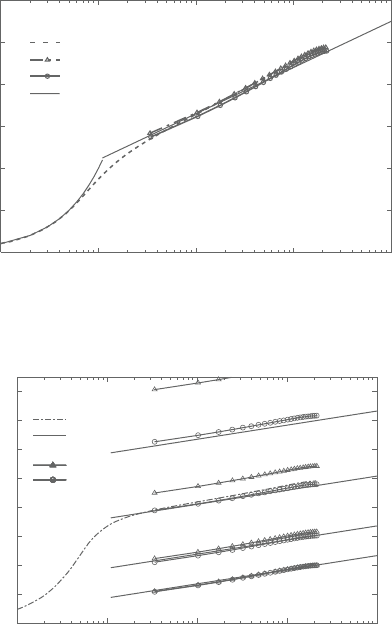
Sunden CH009.tex 25/8/2010 10: 57 Page 363
AWFs of turbulence for complex surface flow phenomena 363
0
5
10
15
20
25
30
1 10 100 1,000 10,000
U
+
y
+
Re = 10
5
LS
k- + AWF(+corr.)
k- + AWF(no corr.)
Log − Law
Figure 9.24. Mean velocity profiles in turbulent smooth channel flows.
Θ
+
y
+
}
Re = 10
5
Pr = 10.0
LS(Pr = 5.0)
Kader
k - ε+AWF(+ corr.)
k - ε+AWF(no corr.)
5.0
2.0
0.71
110
0
10
20
30
40
50
60
70
80
100 1,000 10,000
Figure 9.25. Mean temperature profiles in turbulent smooth channel flows.
means that the correction of µ
t
is made only in the energy equation in the present
strategy.
Figure 9.25 clearly indicates that without the correction, the AWF does not
properlyreproducethelogarithmictemperatureprofilesinhighPrflowsofPr≥5.0.
Note that the experimentally suggested logarithmic distribution by Kader [44] for
a wide range of Pr is:
+
= 2.12ln(y
+
Pr) +(3.85Pr
1/3
− 1.3)
2
(88)
In the case of Pr=0.71, the profiles of the AWF with and without the correction
are virtually identical and confirm that the near-wall correction of µ
t
is effective
for flows at Pr> 1.0.
As shown in Figure 9.26a, the corrected AWF proves its good performance in
the range of 50≤Pr≤10
3
. However, both the LRN LS model and the AWF with
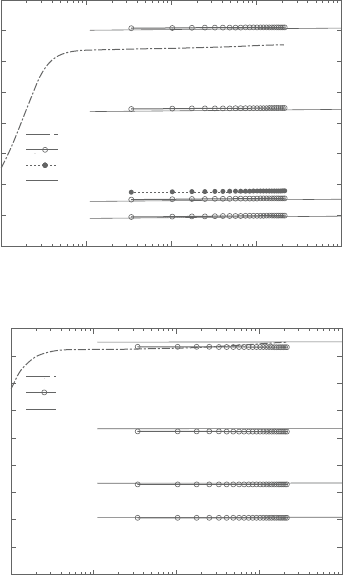
Sunden CH009.tex 25/8/2010 10: 57 Page 364
364 Computational Fluid Dynamics and Heat Transfer
(a)
0
200
400
600
800
1,000
1,200
1,400
1,600
1 10 100 1,000 10,000
Θ
+
y
+
1 10 100 1,000 10,000
y
+
500
100
50
LS (Pr = 500)
k-
ε +AWF(Gerasimov,Pr = 500)
Kader
(b)
0
2,000
4,000
6,000
8,000
10,000
12,000
14,000
16,000
18,000
Θ
+
Re = 10
5
Re = 10
5
Pr = 10
3
Pr = 4 × 10
4
2 × 10
4
5 × 10
3
1 × 10
4
k-ε +AWF(+corr.)
LS (Pr = 2 × 10
4
)
Kader
k-
ε +AWF(+corr.)
Figure 9.26. Mean temperature profiles in turbulent smooth channel flows at
higher Pr.
Gerasimov’s [17] effective molecular Prandtl number scheme f ail to predict the
thermal field at Pr=500. The former predicts the temperature too high and the
latter does too low. Figure 9.26b also confirms that the corrected AWF performs
well up to Pr=4×10
4
though the LRN LS model predicts the thermal field too
high. Note that the same grid resolution as that for Pr=5.0 is used in the LRN
computations. This reasonably implies that the grid resolution used is too coarse
andamuchfinergridisneededforsuchahighPrcomputationsbytheLRNmodels.
Obviously, it highlights the merit of using the AWF which does not require a finer
grid resolution for a higher Pr flow.
Rough wall heat transfer. Figure 9.27 compares the predicted temperature fields
of turbulent rough channel flows of h/D=0.01 and 0.03, (D is channel height). In
thecasesofh/D =0.01,thecorrespondingroughnessReynoldsnumberish
+
60
which is in the transitional roughness regime, while h/D = 0.03 corresponds
to h
+
220 which is well in the fully rough regime. For each roughness case,
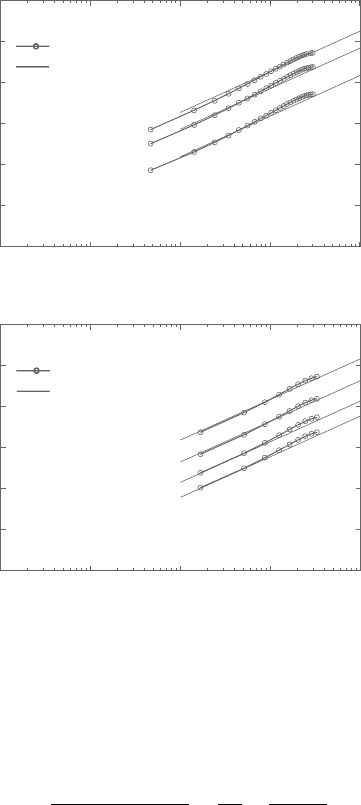
Sunden CH009.tex 25/8/2010 10: 57 Page 365
AWFs of turbulence for complex surface flow phenomena 365
(a)
0
5
10
15
20
25
30
1 10 100 1,000 10,000
Θ
+
y
+
Pr = 10.0
5.0
0.71
Pr = 10.0
5.0
0.71
2.0
(b)
0
5
10
15
20
25
30
1 10 100 1,000 10,000
Θ
+
y
+
Re = 10
5
, h/D = 0.01
Re = 10
5
, h/D = 0.03
Kays-Crawford
k-ε+AWF(+corr.)
Kays-Crawford
k-ε + AWF(+corr.)
Figure 9.27. Mean temperature profiles in turbulent rough channel flows.
it is obvious that the corrected AWF reasonably well reproduces the temperature
distribution for rough walls [45]:
+
=
1
0.8h
+
−0.2
Pr
−0.44
+
Pr
t
κ
ln
32.6y
+
h
+
(89)
where Pr
t
=0.9 and κ = 0.418. This correlation is based on the experiments of
Pr= 1.20 to 5.94 at the order of Re is 10
4
to 10
5
.
9.4.6 AWF for high Schmidt number flows
Turbulentmasstransferacrossliquidinterfacesissometimesveryimportantinengi-
neering and environmental issues. For example, in order to estimate the amount of
the absorption of atmospheric CO
2
(carbon dioxide) at the sea surface, one should
consider predicting turbulent mass transfer across air–water interfaces. The diffi-
culty of analysing such a phenomenon comes from that the concentration (scalar)
